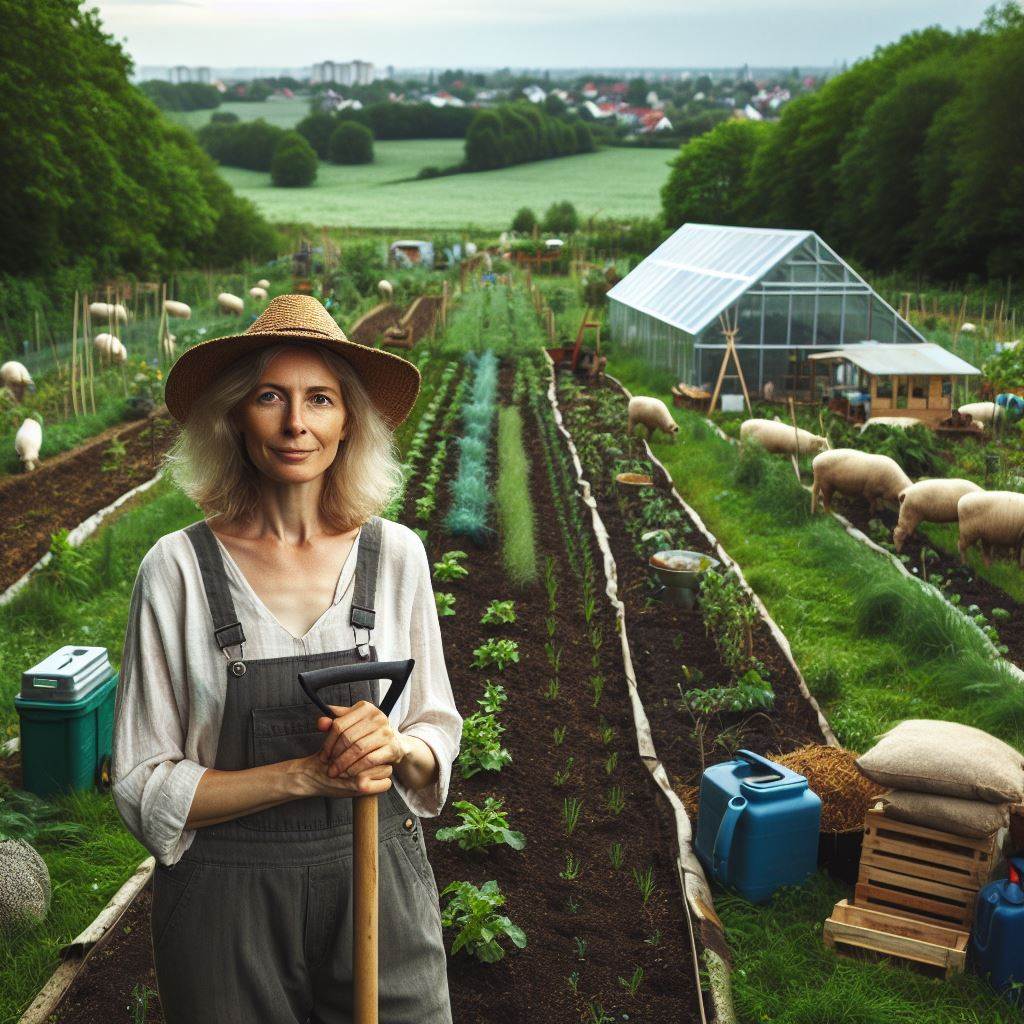Introduction
Eco-farming, also known as ecological farming or sustainable agriculture, aims to cultivate crops and raise livestock while minimizing the negative impact on the environment.
It promotes biodiversity, soil fertility, and natural resource conservation. By implementing eco-farming techniques, farmers prioritize the long-term sustainability of their farms.
Sustainable agricultural practices are crucial in addressing the challenges of modern agriculture.
With a growing global population, it is vital to produce food in a way that does not deplete natural resources or harm the ecosystem.
Eco-farming promotes a holistic approach that takes into account environmental, economic, and social factors.
This blog post will delve into various eco-farming practices that can be adopted by farmers.
It will explore techniques such as organic farming, agroforestry, crop rotation, and integrated pest management.
These practices aim to reduce chemical inputs, increase soil fertility, enhance water management, and promote beneficial ecosystems.
Furthermore, the post will highlight the benefits of eco-farming. It will discuss how sustainable agricultural practices can improve soil health, protect biodiversity, conserve water, and mitigate climate change.
Additionally, the blog will touch upon the economic advantages of eco-farming, such as increased profitability and market demand for organic produce.
In short, eco-farming is a vital approach to sustainable agriculture.
By implementing eco-friendly techniques, farmers can ensure the long-term viability of their farms, protect the environment, and provide healthy food for future generations.
This blog post will serve as a comprehensive overview of eco-farming practices and their significance in creating a sustainable food system.
Benefits of Eco-Farming
Eco-farming, with its emphasis on sustainable practices, brings numerous benefits to the environment, economy, and society. Let’s explore these benefits in detail.
Environmental benefits
Soil conservation and improvement
Through eco-farming, farmers adopt practices such as crop rotation, cover cropping, and organic fertilization.
Transform Your Agribusiness
Unlock your farm's potential with expert advice tailored to your needs. Get actionable steps that drive real results.
Get StartedThese techniques help prevent soil erosion, enhance soil fertility, and reduce the need for synthetic inputs.
By maintaining healthy soil, eco-farming contributes to long-term agricultural sustainability.
Biodiversity conservation
Eco-farming preserves and enhances natural habitats, safeguarding the diversity of plant and animal species.
By avoiding the use of chemical pesticides and genetically modified organisms (GMOs), eco-farmers provide a safe haven for beneficial insects, birds, and pollinators.
This leads to a healthier and more balanced ecosystem.
Water management and conservation
Eco-farming practices prioritize efficient water use. Techniques like drip irrigation, rainwater harvesting, and proper drainage systems minimize water waste and depletion.
By preserving water resources, eco-farming ensures their availability for future generations and reduces the impact on aquatic ecosystems.
Economic benefits
Increased yields and reduced input costs
Eco-farming methods, such as organic farming and agroforestry, can result in comparable or even higher yields compared to conventional farming.
Additionally, by minimizing dependency on chemical inputs, farmers can reduce production costs, leading to improved profitability.
Access to niche markets and premium prices
Consumers are increasingly seeking environmentally friendly and healthy food options.
Eco-farmers, who follow strict organic and sustainable standards, can target niche markets and command premium prices for their products. This creates new market opportunities and increases farm revenue.
Social benefits
Improved health and safety for farmers and consumers
Eco-farming minimizes the use of harmful synthetic pesticides and fertilizers. This reduces the health risks associated with exposure to these chemicals.
By opting for eco-farming, farmers prioritize their health and safety, as well as the well-being of consumers who consume their produce.
Stronger local communities and rural development
Eco-farming promotes interconnectedness within local communities. Supporting local, sustainable agriculture fosters social cohesion and strengthens relationships between farmers, consumers, and neighboring businesses.
It also contributes to the vitality and resilience of rural areas, stimulating economic growth and development.
In fact, eco-farming offers a range of benefits that extend beyond the farm gate.
By prioritizing environmental sustainability, eco-farming practices contribute to soil conservation, biodiversity conservation, and efficient water management.
These practices also have economic advantages, including increased yields, reduced input costs, and access to premium markets.
Furthermore, eco-farming enhances social well-being by promoting the health and safety of farmers and consumers, as well as fostering stronger local communities and rural development.
Embracing eco-farming is not only a responsible choice but also a pathway to a more sustainable, prosperous, and harmonious future.
Read: Permaculture 101: Key Principles Explained
Key Principles of Eco-Farming
Eco-farming is a holistic approach to agriculture that focuses on sustainable practices and environmental stewardship.
It aims to minimize the negative impact of farming on the ecosystem while ensuring high-quality and nutritious food production.
Organic farming
One of the key principles of eco-farming is organic farming. This practice emphasizes the use of natural fertilizers, such as compost or manure, and pest control methods, such as biological controls or crop rotation.
Showcase Your Farming Business
Publish your professional farming services profile on our blog for a one-time fee of $200 and reach a dedicated audience of farmers and agribusiness owners.
Publish Your ProfileSynthetic chemicals and genetically modified organisms (GMOs) are strictly prohibited in organic farming to protect both human health and the environment.
Conservation agriculture
Conservation agriculture is another vital principle of eco-farming. It aims to preserve soil health and structure by reducing soil disturbance.
Instead of tilling the soil extensively, conservation agriculture promotes minimal soil disturbance through techniques like no-till farming or reduced tillage.
Crop rotation and cover cropping are also essential components of conservation agriculture, as they help maintain soil fertility, minimize nutrient depletion, and control pests naturally.
Agroforestry
Agroforestry is a practice that integrates trees, crops, and livestock on the same plot of land.
By having multiple species in one system, agroforestry enhances biodiversity and promotes ecological balance.
Trees provide shade, windbreaks, and habitat for beneficial insects, while their deep roots help combat soil erosion.
The combination of trees, crops, and livestock also improves land productivity and increases resilience to climate change.
Water and energy management
Water and energy management play a crucial role in eco-farming. Efficient irrigation techniques, such as drip irrigation or precision sprinklers, reduce water usage and minimize water wastage.
Eco-farming also promotes the use of renewable energy sources, such as solar panels or wind turbines, to power farming operations.
By decreasing reliance on fossil fuels, eco-farming contributes to reducing greenhouse gas emissions and mitigating climate change.
Adopting the key principles of eco-farming not only benefits the environment but also yields numerous advantages for farmers and consumers.
Eco-farming practices lead to healthier soils, increased biodiversity, improved water quality, and reduced pesticide residues in food.
Additionally, eco-farmed products are often perceived as more sustainable and environmentally friendly, appealing to a growing market of consumers who prioritize ethical and sustainable choices.
In fact, eco-farming encompasses various principles that promote sustainable agriculture.
Organic farming, conservation agriculture, agroforestry, and water and energy management are key components of eco-farming practices.
By adopting these principles, farmers can contribute to preserving the environment, enhancing biodiversity, and producing nutritious and high-quality food for a sustainable future.
Read: Wind Farms in Agriculture: A Guide

Success Stories of Eco-Farming Practices
First Case study: Organic farming in Fattoria La Vialla
- Fattoria La Vialla underwent a conversion process to transition from conventional farming to organic methods.
- During the initial stages, they faced several challenges such as pest control and weed management without chemicals.
- Despite the challenges, Fattoria La Vialla persevered and successfully implemented sustainable practices.
- The farm saw significant improvements in soil health, with increased organic matter and microbial activity.
- As a result, the crops grew more resilient and the overall yields increased, ensuring long-term productivity.
Second Case study: Conservation agriculture in Sundrop Farms
- Sundrop Farms adopted innovative techniques such as no-till farming and cover cropping.
- These practices helped reduce soil erosion and maintain soil structure and fertility.
- By avoiding aggressive tillage, Sundrop Farms preserved the soil’s natural habitat and ecosystem.
- Cover cropping provided additional benefits by improving soil water holding capacity and reducing evaporation rates.
- Overall, the adoption of conservation agriculture practices improved agricultural sustainability and productivity.
Third Case study: Agroforestry in Polyface Farm
- Polyface Farm implemented agroforestry techniques by integrating trees and livestock grazing.
- This approach helped create a balanced and sustainable ecosystem on the farm.
- Trees provided shade for the livestock, reducing heat stress and improving animal welfare.
- Livestock grazing also helped in nutrient cycling, as their manure contributed to soil fertility.
- The presence of trees on the farm diversified the landscape and enhanced the microclimate, benefiting overall farm productivity.
In essence, these success stories highlight the effectiveness of eco-farming practices in promoting sustainability and enhancing agricultural outcomes.
Fattoria La Vialla’s adoption of organic farming resulted in improved soil health and increased yields.
Sundrop Farms’ implementation of conservation agriculture led to reduced erosion and enhanced water holding capacity.
Polyface Farm’s agroforestry practices demonstrated the benefits of integrating trees and livestock grazing for diversification and improved microclimate.
These case studies showcase the positive impact of eco-farming practices and serve as inspiration for farmers seeking sustainable alternatives.
Read: Farming and Solar: A Perfect Match
Challenges and Potential Solutions
Scaling up sustainable practices
Scaling up sustainable practices in agriculture faces several challenges that need to be addressed for successful implementation.
One of the primary obstacles is the financial barrier faced by farmers.
Adopting sustainable farming methods often requires investment in new technologies, tools, and infrastructure, which can be costly.
Limited access to financial resources further exacerbates this issue, especially for small-scale farmers.
To overcome these challenges, policies that support sustainable farming practices and provide incentives to farmers are essential.
Governments and agricultural organizations can offer financial assistance, grants, and low-interest loans to enable farmers to transition to eco-farming.
Such initiatives can alleviate the financial burden and encourage more farmers to adopt sustainable practices.
Knowledge dissemination and training
Another critical challenge in promoting eco-farming is the lack of awareness and technical skills among farmers.
Many farmers may not be fully aware of the benefits of sustainable practices or the specific methods they can employ.
Technical skills required for successful implementation may also be lacking in certain regions.
To address these challenges, farmer education is crucial. Providing training programs and workshops that focus on sustainable farming techniques can help disseminate knowledge among farmers.
Agricultural extension services can play a vital role in reaching out to farmers and offering guidance on implementing eco-friendly practices.
By equipping farmers with the necessary knowledge and skills, they can confidently adopt sustainable farming methods.
Consumer demand and market access
One of the key drivers for scaling up sustainable practices is consumer demand for eco-friendly products.
However, there are challenges in marketing and certification that need to be addressed.
Organic and sustainable products often face difficulties in establishing their market presence.
Showcase Your Farming Business
Publish your professional farming services profile on our blog for a one-time fee of $200 and reach a dedicated audience of farmers and agribusiness owners.
Publish Your ProfileCertification processes can be time-consuming and costly for farmers, hindering their ability to access the eco-conscious consumer market.
To overcome these challenges, marketing efforts should focus on highlighting the benefits of sustainable farming methods and the positive environmental impact.
Certification procedures need to be streamlined and made more accessible to farmers.
Additionally, consumer education and promotion campaigns can create awareness and encourage consumers to choose eco-friendly products.
By increasing consumer demand, farmers can have better market access and get fair prices for their sustainable produce.
In a nutshell, scaling up sustainable farming practices requires addressing challenges in different areas.
Financial barriers and limited access to resources can be overcome through policy support and incentives.
Knowledge dissemination and training programs are essential to equip farmers with the technical skills needed for sustainable farming.
Enhancing consumer demand and improving market access can be achieved through effective marketing, certification support, and consumer education campaigns.
By tackling these challenges, eco-farming can become more widespread, contributing to a greener and more sustainable future in agriculture.
Read: Biomass Use in Eco-Agriculture
Conclusion
Eco-farming, also known as sustainable agriculture, plays a crucial role in combating environmental degradation and ensuring food security.
By adopting organic methods and reducing chemical inputs, eco-farming promotes biodiversity and soil health.
It is our responsibility as consumers and farmers to support and promote sustainable agricultural practices.
By purchasing organic products and advocating for eco-friendly farming methods, we can contribute towards building a resilient and sustainable food system.
We hope that this overview of eco-farming has inspired you to learn more about sustainable practices.
Stay tuned for upcoming blog sections where we delve deeper into specific eco-farming topics and provide practical tips for implementing them in your own agricultural endeavors.
Remember, small actions can make a big difference in preserving our environment and ensuring a healthier future for generations to come.
Let’s work together towards a more sustainable and resilient food system.




